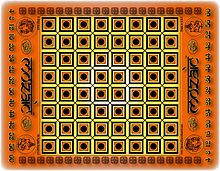- Mozaic
-
Mozaic (board game) Designer(s) Martin H. Samuel Illustrator(s) Martin H. Samuel Publisher(s) Games Above Board
Sterling GamesPlayers 2 Age range 8 and up Setup time 1 minute Playing time 30 minutes Skill(s) required Tactics, strategy, concentration Mozaic is a two-player abstract strategy board game, played with glass gemstones, using luck of the draw, placement and points accumulation. In the latter stages of play, a second tier within the game becomes apparent, demanding a change of tactics.
The game was designed by Martin H. Samuel and originally produced by Games Above Board.
Sunnywood, Inc., of Hong Kong, licensed the game and published it by Sterling Games in 2003.
Giseh Verlag launched the game in Germany at Essen Spiel in 2006.
An Axiom-powered electronic version of Mozaic was programmed for PC by Greg Schmidt in 2010.
Contents
Components
Tiled game board
1 emerald-green, 1 ruby-red, 1 diamond-white, 1 onyx-black, 35 amber-golden and 35 cobalt-blue glass gemstones (extra gemstones are provided for each player)
Velour pouch
InstructionsObjective
The goal of the game is, to score the most points by placing your gemstones on the board - building and/or blocking point-scoring squares.
Gameplay
The Mozaic game board consists of 64 tiles (8x8 squares) with a score-keeping "ladder" on either end.
Players choose either amber or cobalt and use 32 same-color gemstones + 1 score-keeper each - four exception gems are included:- ruby-red = miss this turn.
- sapphire-green = slide any gem diagonally to an empty adjacent tile.
- onyx-black = take two turns.
- diamond-white = remove any gem from the board and replace it in the bag.
Exception gemstones are always returned to the bag after a turn.
Start with an empty board, end with a full board ...
The gemstones are placed in the bag and the first player to draw their color from the bag starts. Players then take turns drawing gems, one at a time, and place them on any empty tile on the board.
4 points are scored when placement of four same-color adjacent gems forming a square is completed - existing squares may be built on and expanded.Points are won with a player's own-color gems (even when placed by the opponent) and always accrued, never deducted. Several point-scoring combinations may be completed at one time with a single gem. Overlooked points are forfeited and, throughout the game, players keep score on their side of the board with an extra gem of their color.
The game is over when the last gemstone is placed, all the tiles are covered and only the four exception gems remain in the bag then, by comparing accrued points totals, the player with the most points is the winner of the game.
References
[1] Games Above Board
[2] Sunnywood, Inc. / Sterling Games
[3] Essen Spiel 2006
[4] GameBoardGeekExternal links
Categories:- Board games
- Abstract strategy games
Wikimedia Foundation. 2010.



